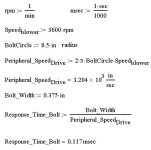grobertson
Member
I'm having trouble getting a simple zero speed setup to work. when the machine is running my prox is sending pulses at 90hz and the plc only scans at 50hz. Is this a problem.
Rick Densing said:One big 180 degree target isn't going to give him much resolution when it comes to detecting zero speed.
Me said:Ideally, the more flags the better, up to the frequency limits of the prox or PLC input (at your max. RPM).

